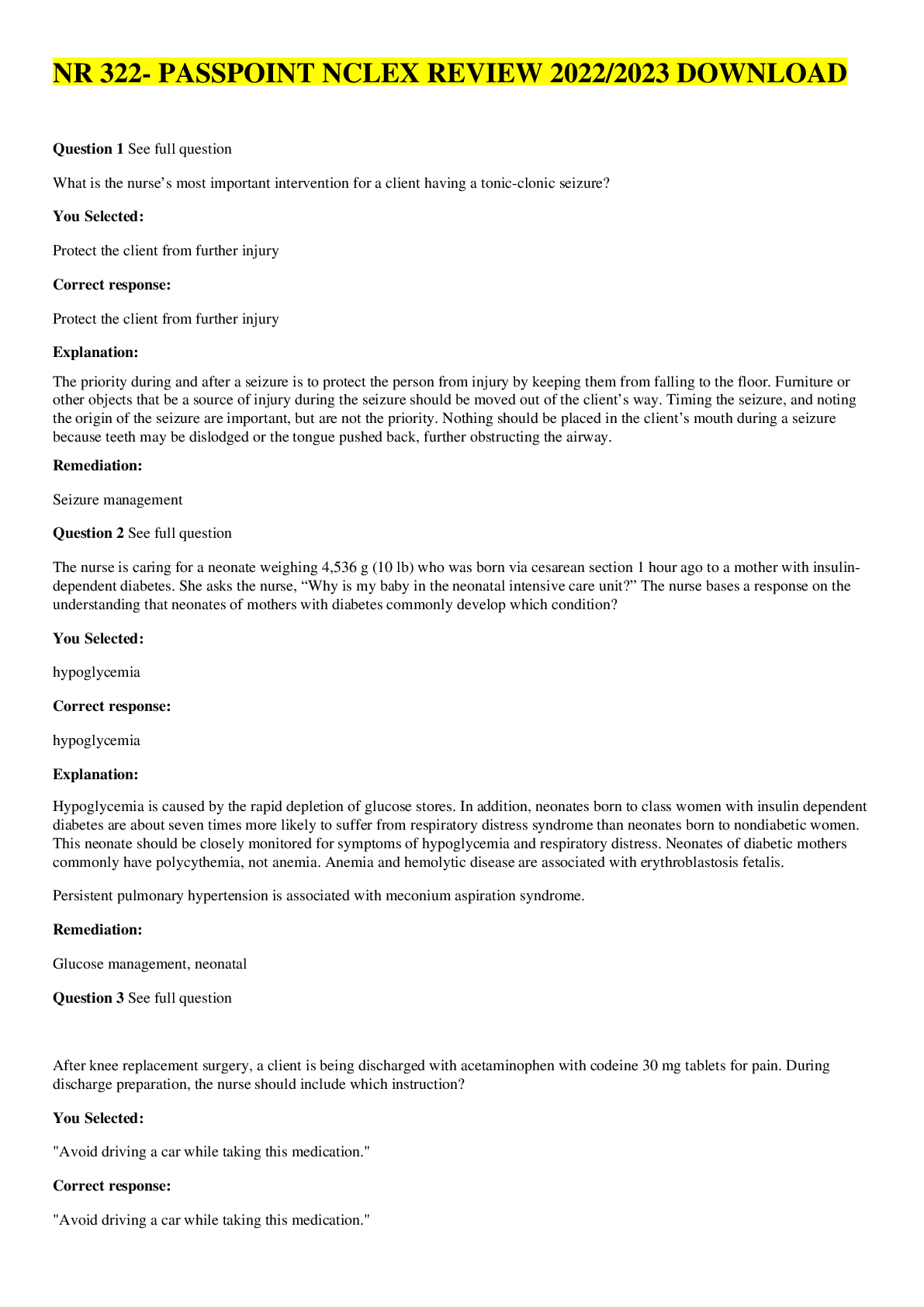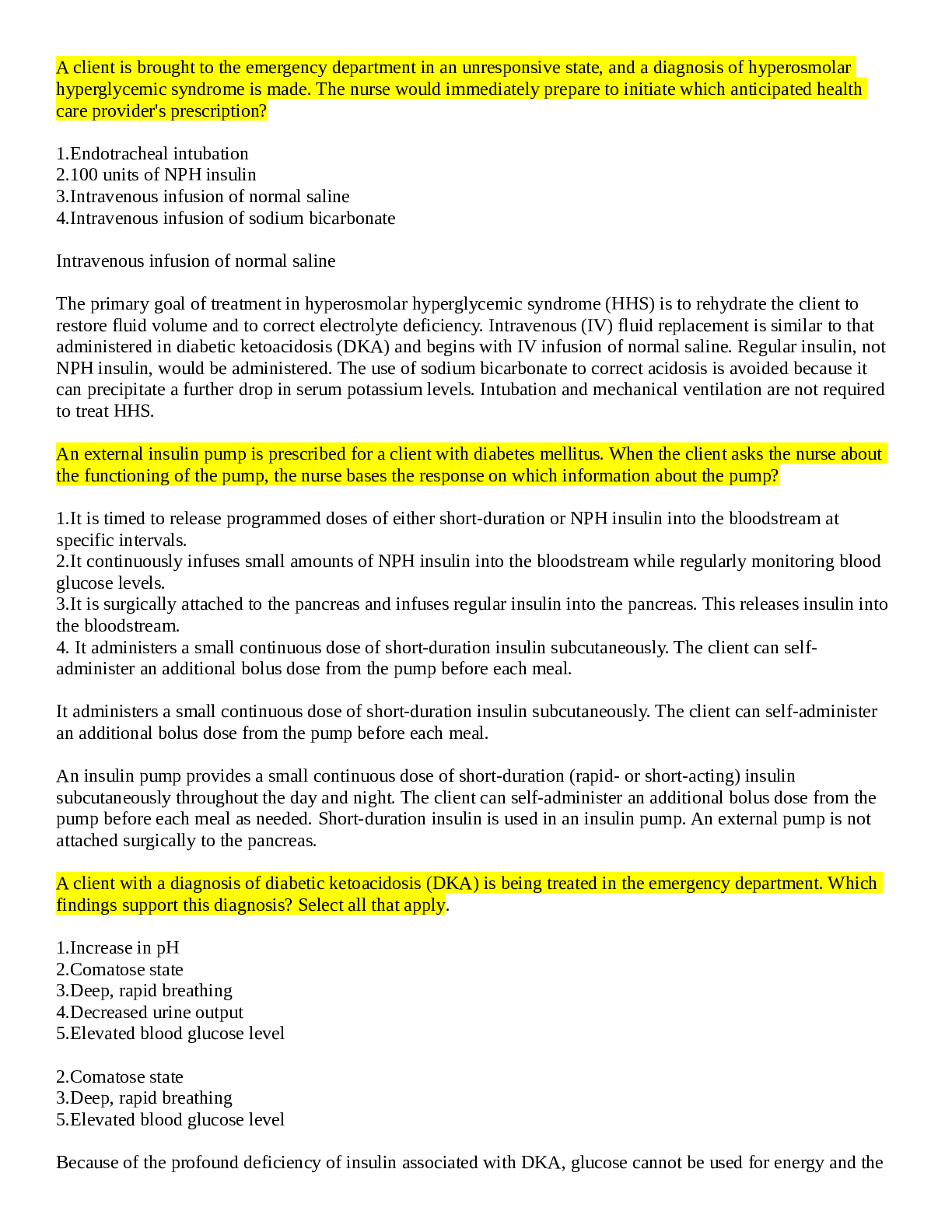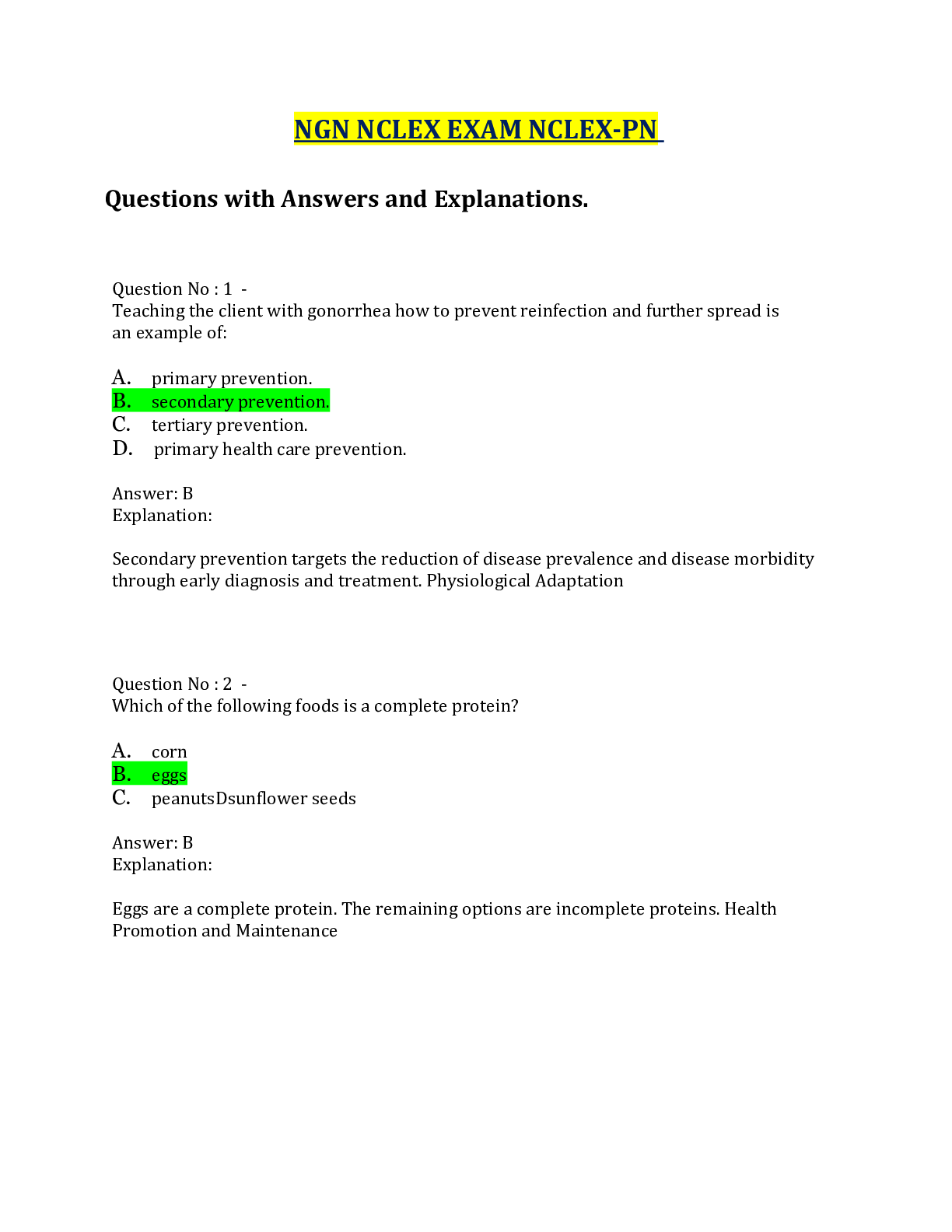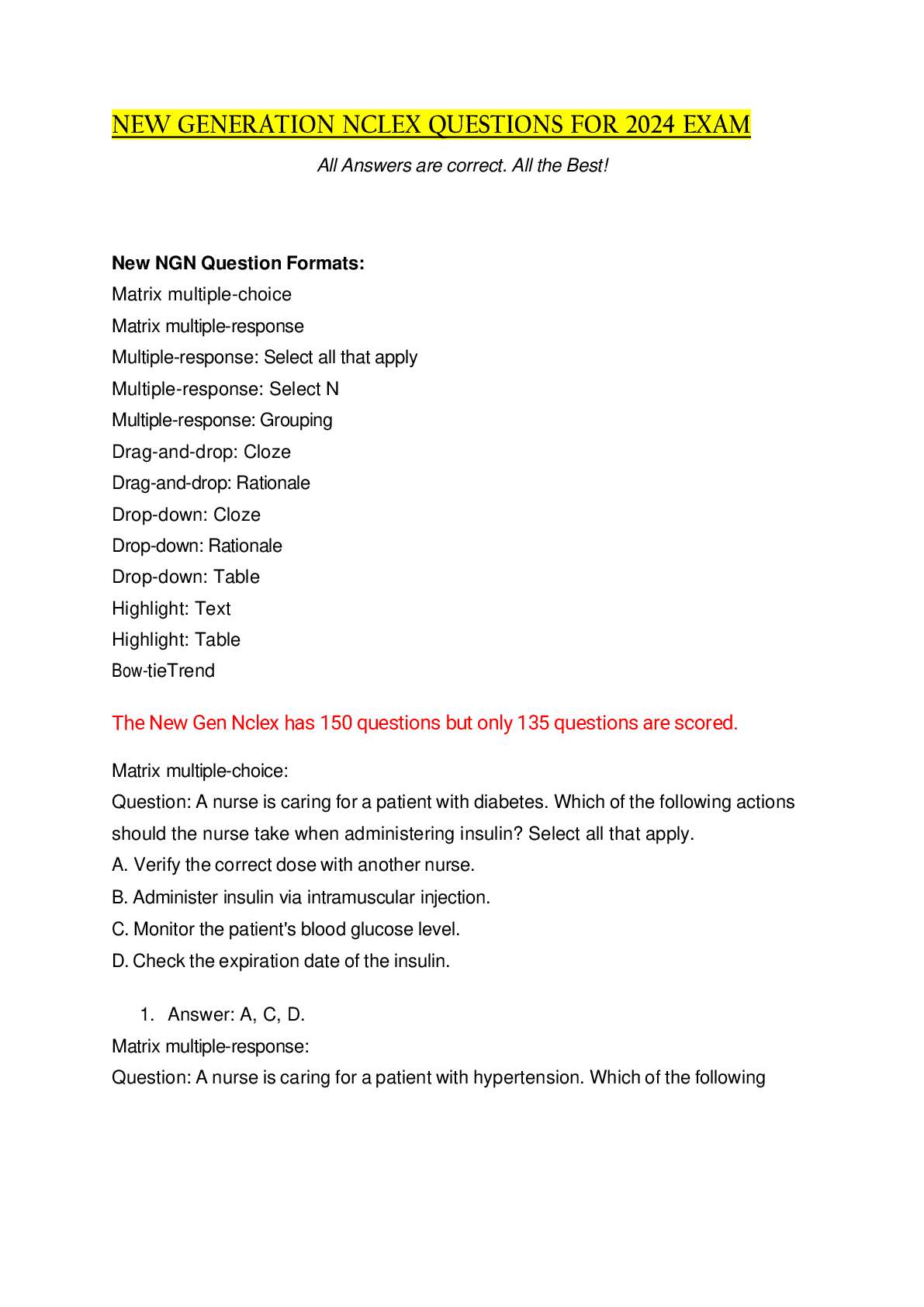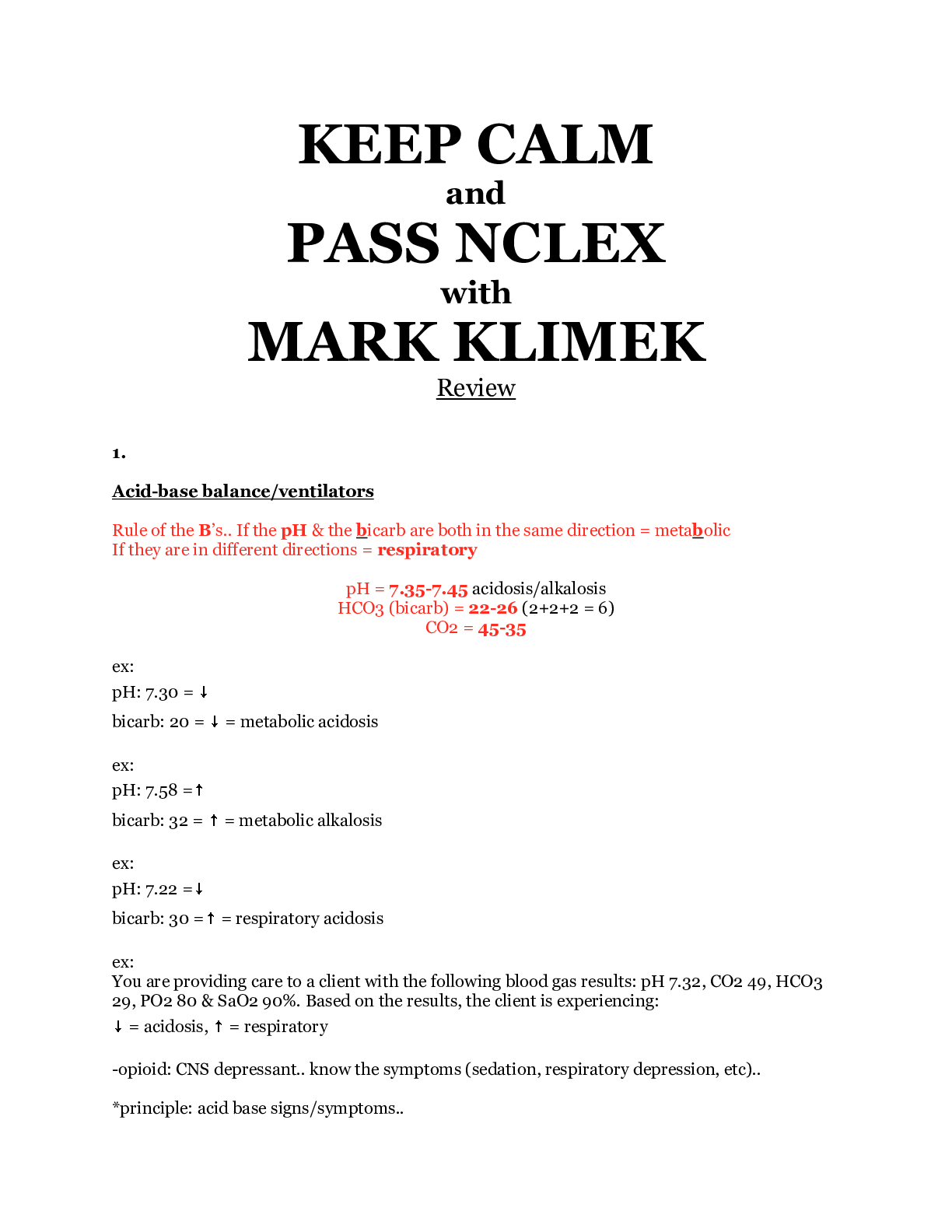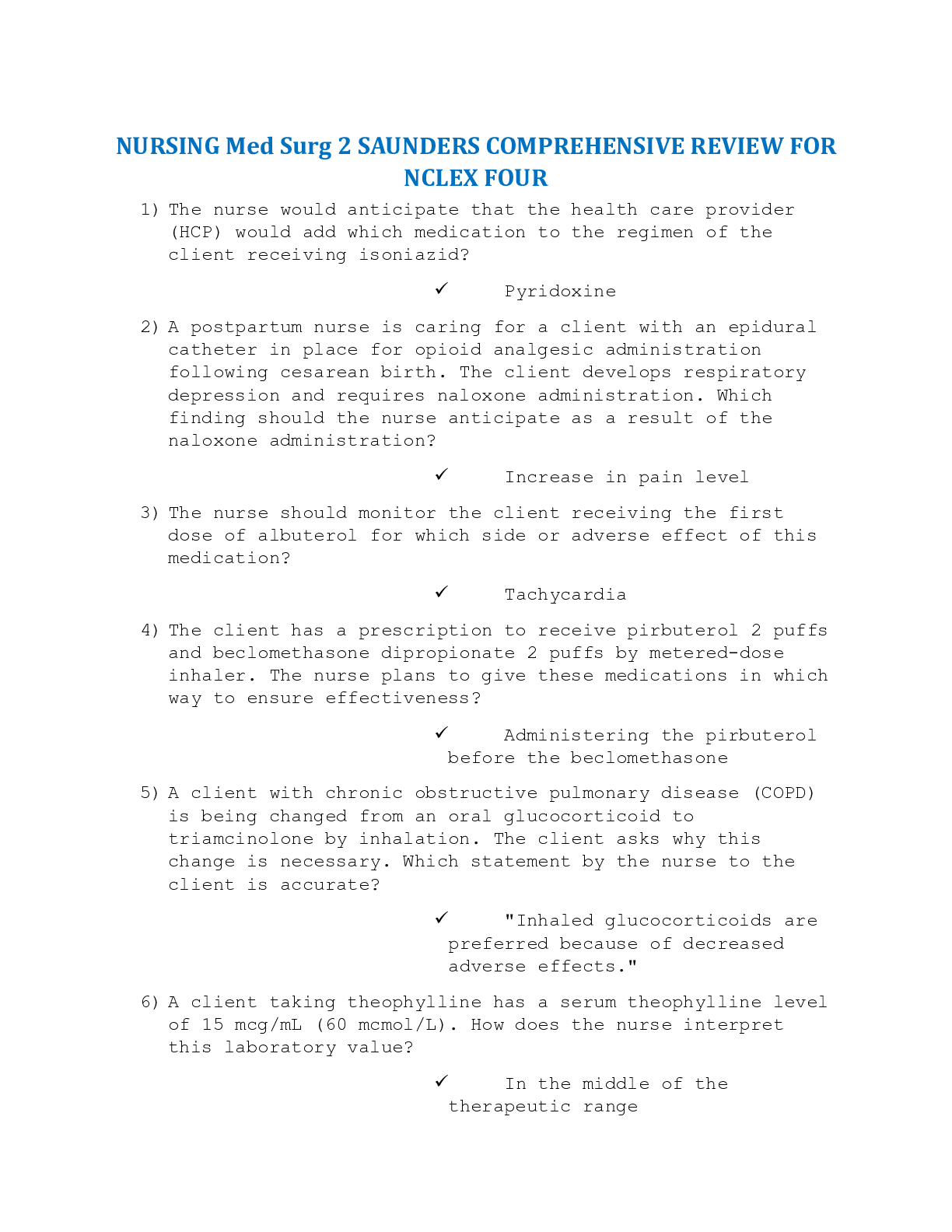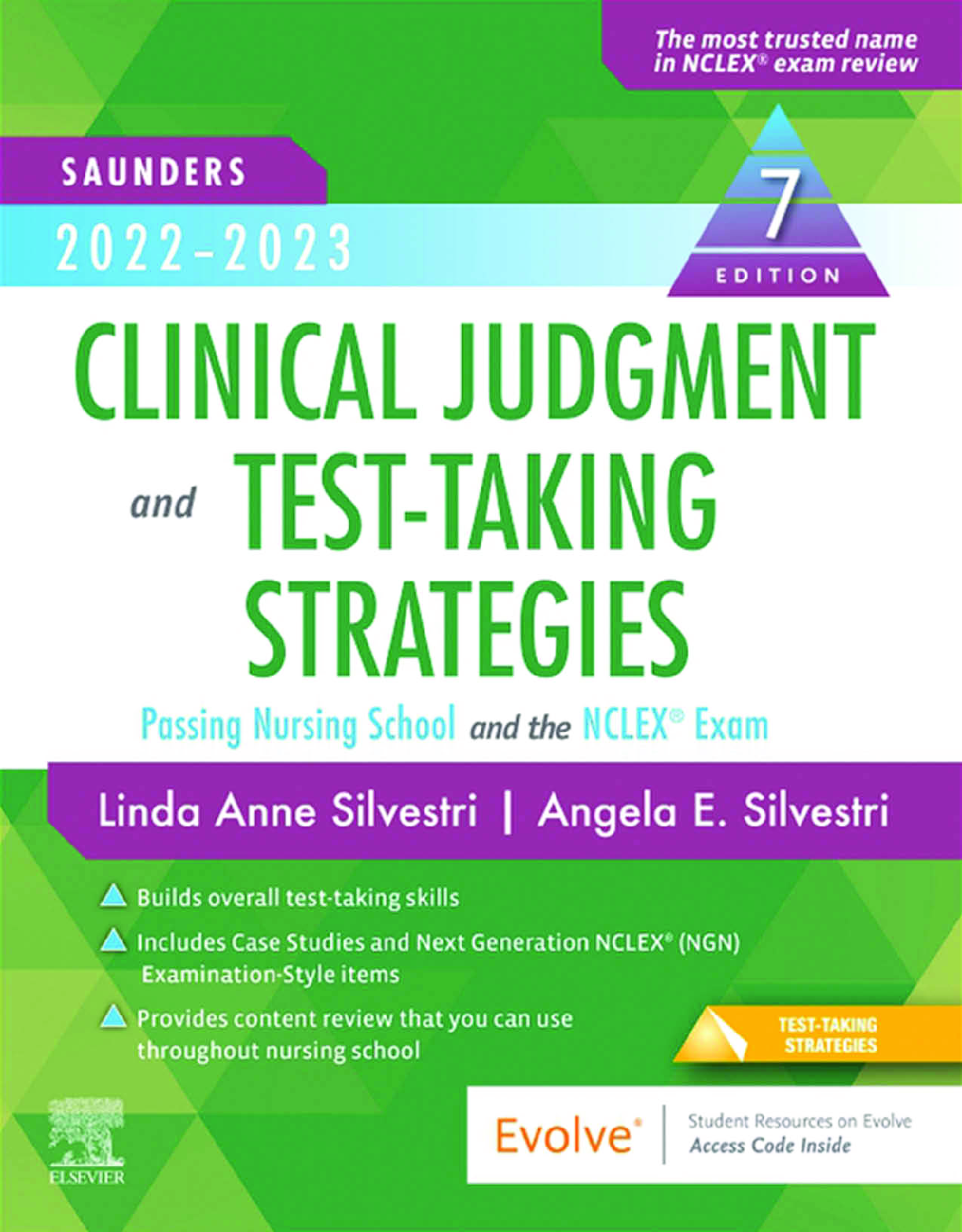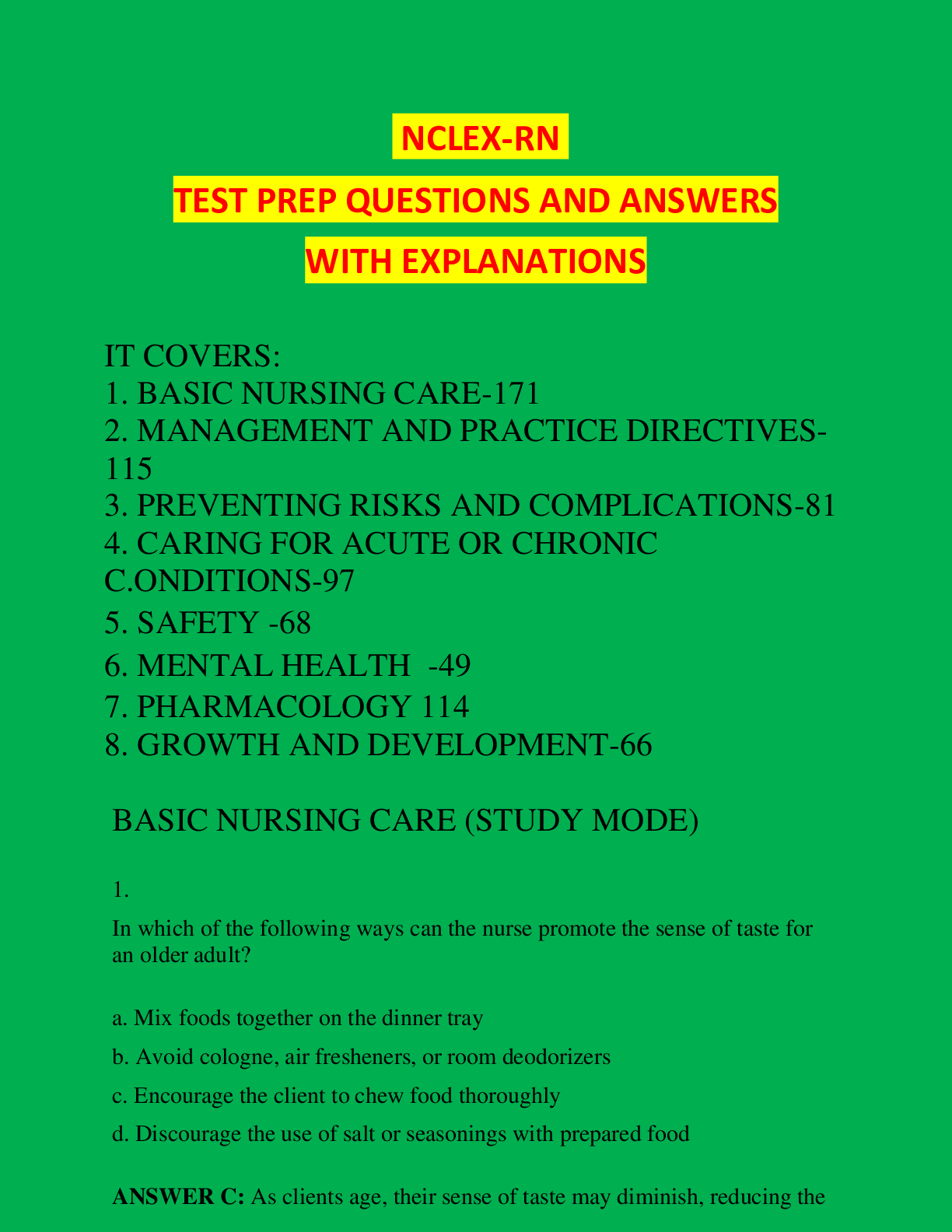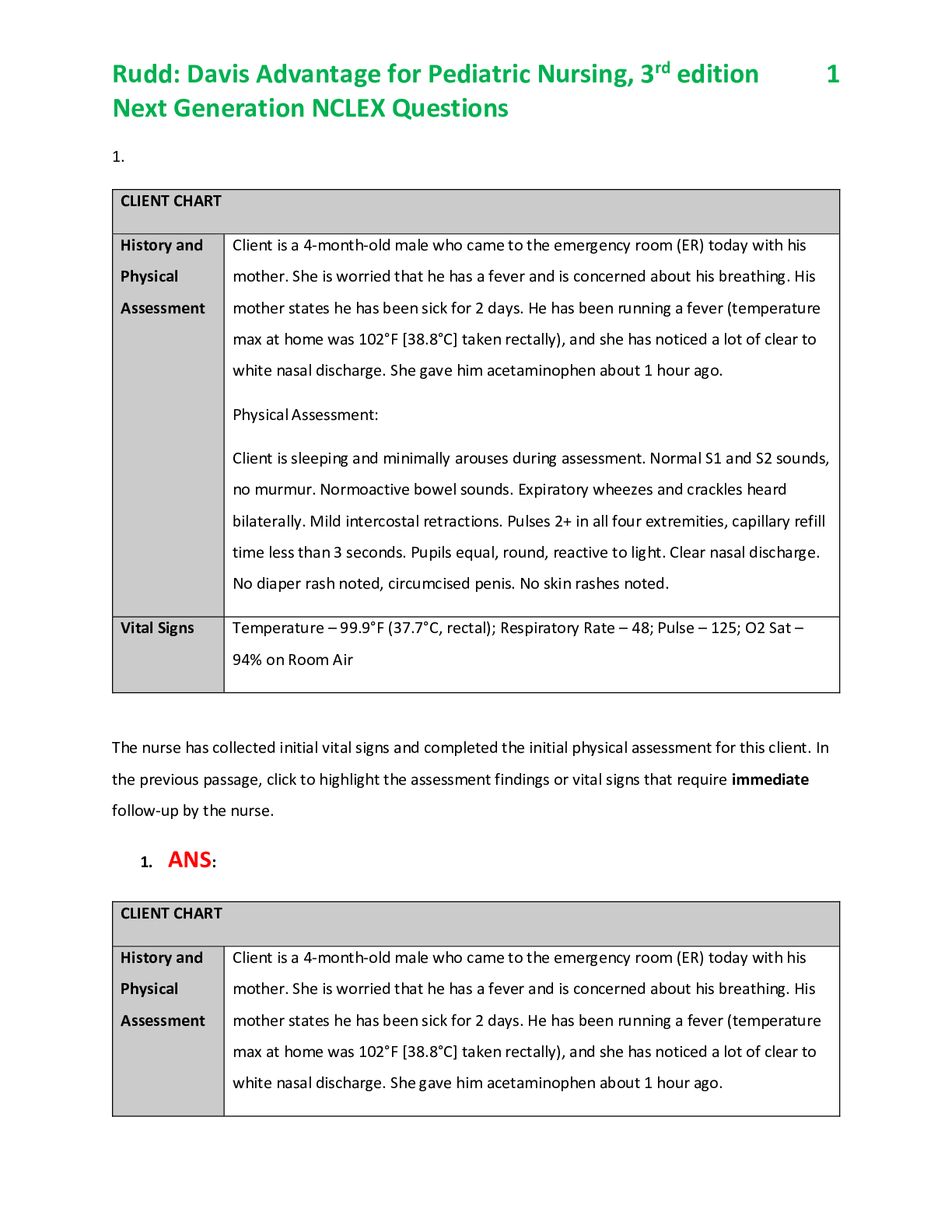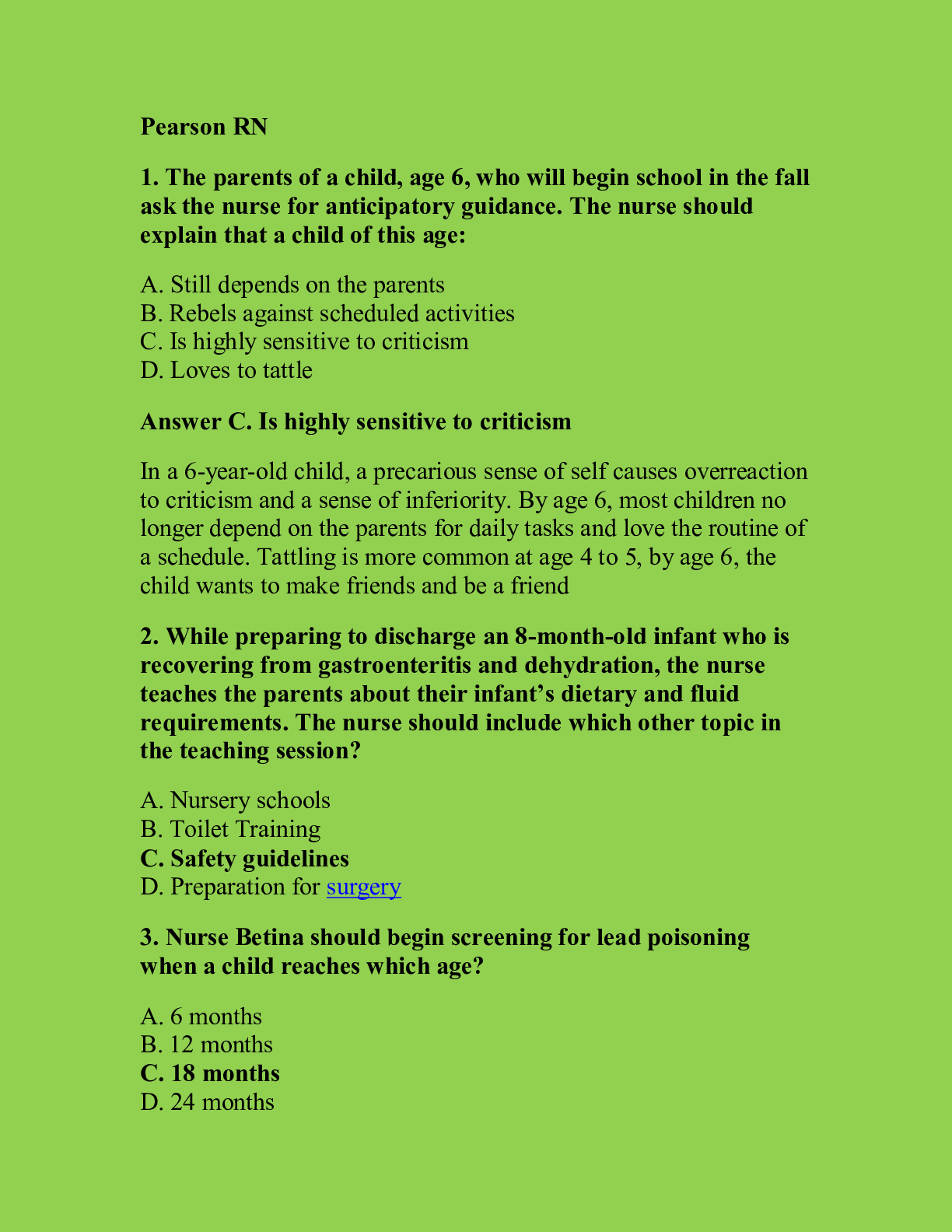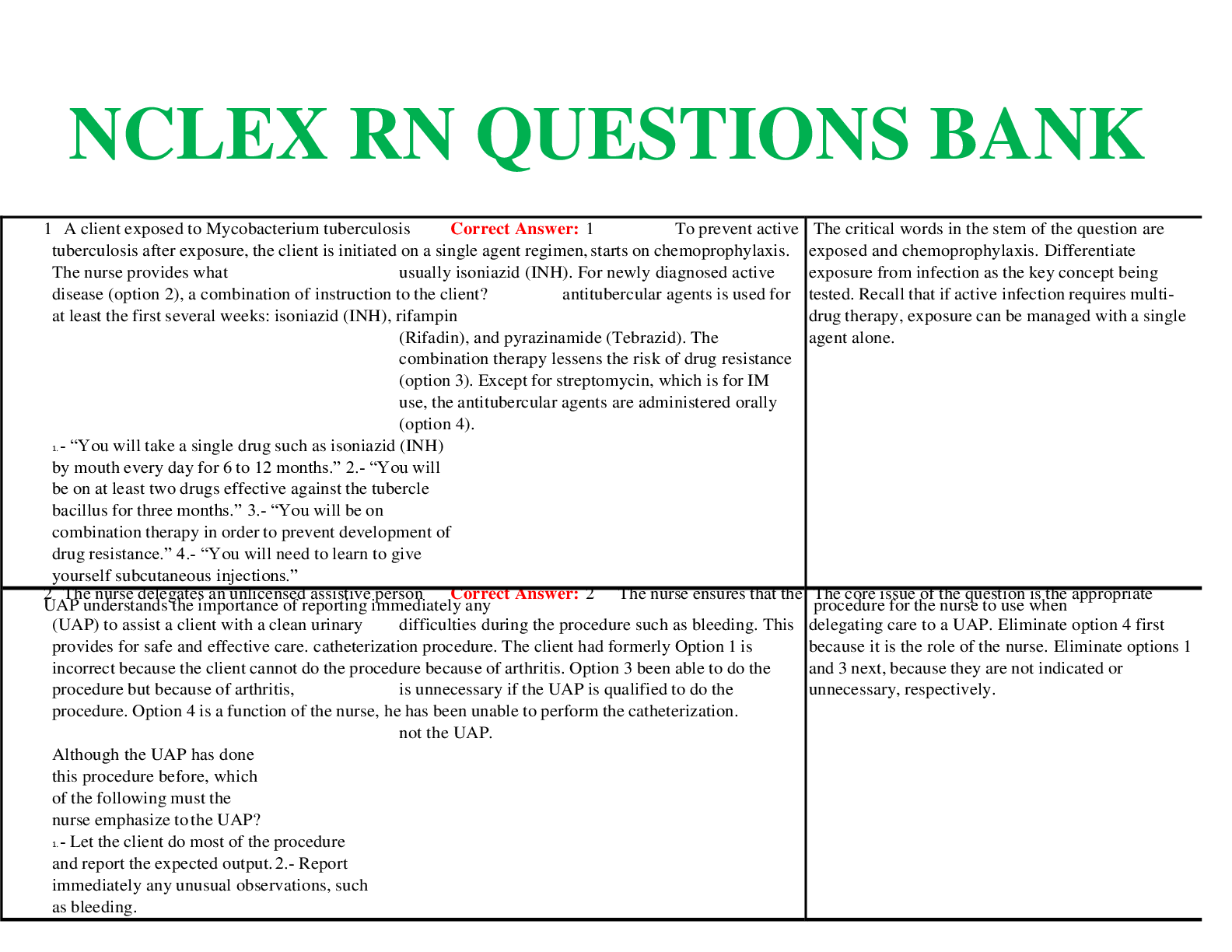*NURSING > NCLEX > NCLEX – ENDOCRINE QUESTIONS AND ANSWERS- LATEST GUIDE CORRECTLY ANSWERED WITH RATIONALES (All)
NCLEX – ENDOCRINE QUESTIONS AND ANSWERS- LATEST GUIDE CORRECTLY ANSWERED WITH RATIONALES
Document Content and Description Below
NCLEX – ENDOCRINE QUESTIONS AND ANSWERS- LATEST GUIDE CORRECTLY ANSWERED WITH RATIONALES A client is brought to the emergency department in an unresponsive state, and a diagnosis of hyperosmolar h... yperglycemic syndrome is made. The nurse would immediately prepare to initiate which anticipated health care provider's prescription? 1.Endotracheal intubation 2.100 units of NPH insulin 3.Intravenous infusion of normal saline 4.Intravenous infusion of sodium bicarbonate Intravenous infusion of normal saline The primary goal of treatment in hyperosmolar hyperglycemic syndrome (HHS) is to rehydrate the client to restore fluid volume and to correct electrolyte deficiency. Intravenous (IV) fluid replacement is similar to that administered in diabetic ketoacidosis (DKA) and begins with IV infusion of normal saline. Regular insulin, not NPH insulin, would be administered. The use of sodium bicarbonate to correct acidosis is avoided because it can precipitate a further drop in serum potassium levels. Intubation and mechanical ventilation are not required to treat HHS. An external insulin pump is prescribed for a client with diabetes mellitus. When the client asks the nurse about the functioning of the pump, the nurse bases the response on which information about the pump? 1. It is timed to release programmed doses of either short-duration or NPH insulin into the bloodstream at specific intervals. 2. It continuously infuses small amounts of NPH insulin into the bloodstream while regularly monitoring blood glucose levels. 3. It is surgically attached to the pancreas and infuses regular insulin into the pancreas. This releases insulin into the bloodstream. 4. It administers a small continuous dose of short-duration insulin subcutaneously. The client can self- administer an additional bolus dose from the pump before each meal. It administers a small continuous dose of short-duration insulin subcutaneously. The client can self-administer an additional bolus dose from the pump before each meal. An insulin pump provides a small continuous dose of short-duration (rapid- or short-acting) insulin subcutaneously throughout the day and night. The client can self-administer an additional bolus dose from the pump before each meal as needed. Short-duration insulin is used in an insulin pump. An external pump is not attached surgically to the pancreas. A client with a diagnosis of diabetic ketoacidosis (DKA) is being treated in the emergency department. Which findings support this diagnosis? Select all that apply. 1.Increase in pH 2.Comatose state 3.Deep, rapid breathing 4.Decreased urine output 5.Elevated blood glucose level 2.Comatose state 3.Deep, rapid breathing 5.Elevated blood glucose level Because of the profound deficiency of insulin associated with DKA, glucose cannot be used for energy and the body breaks down fat as a secondary source of energy. Ketones, which are acid byproducts of fat metabolism, build up and the client experiences a metabolic ketoacidosis. High serum glucose contributes to an osmotic diuresis and the client becomes severely dehydrated. If untreated, the client will become comatose due to severe dehydration, acidosis, and electrolyte imbalance. Kussmaul's respirations, the deep rapid breathing associated with DKA, is a compensatory mechanism by the body. The body attempts to correct the acidotic state by blowing off carbon dioxide (CO2), which is an acid. In the absence of insulin, the client will experience severe hyperglycemia. Option 1 is incorrect because in acidosis the pH would be low. Option 4 is incorrect because a high serum glucose will result in an osmotic diuresis and the client will experience polyuria. The nurse teaches a client with diabetes mellitus about differentiating between hypoglycemia and ketoacidosis. The client demonstrates an understanding of the teaching by stating that a form of glucose should be taken if which symptom or symptoms develop? Select all that apply. 1. Polyuria 2.Shakiness 3.Palpitations 4.Blurred vision 5.Lightheadedness 6.Fruity breath odor 2. Shakiness 3.Palpitations 5.Lightheadedness Shakiness, palpitations, and lightheadedness are signs/symptoms of hypoglycemia and would indicate the need for food or glucose. Polyuria, blurred vision, and a fruity breath odor are manifestations of hyperglycemia. A client with diabetes mellitus demonstrates acute anxiety when admitted to the hospital for the treatment of hyperglycemia. What is the appropriate intervention to decrease the client's anxiety? 1. Administer a sedative. 2. Convey empathy, trust, and respect toward the client. 3. Ignore the signs and symptoms of anxiety, anticipating that they will soon disappear. 4. Make sure that the client is familiar with the correct medical terms to promote understanding of what is happening. Convey empathy, trust, and respect toward the client. Anxiety is a subjective feeling of apprehension, uneasiness, or dread. The appropriate intervention is to address the client's feelings related to the anxiety. Administering a sedative is not the most appropriate intervention and does not address the source of the client's anxiety. The nurse should not ignore the client's anxious feelings. Anxiety needs to be managed before meaningful client education can occur. The nurse provides instructions to a client newly diagnosed with type 1 diabetes mellitus. The nurse recognizes accurate understanding of measures to prevent diabetic ketoacidosis when the client makes which statement? 1. "I will stop taking my insulin if I'm too sick to eat." 2. "I will decrease my insulin dose during times of illness." 3. "I will adjust my insulin dose according to the level of glucose in my urine." 4. "I will notify my health care provider (HCP) if my blood glucose level is higher than 250 mg/dL (14.2 mmol/L)." "I will notify my health care provider (HCP) if my blood glucose level is higher than 250 mg/dL (14.2 mmol/L)." During illness, the client with type 1 diabetes mellitus is at increased risk of diabetic ketoacidosis, due to hyperglycemia associated with the stress response and due to a typically decreased caloric intake. As part of sick day management, the client with diabetes should monitor blood glucose levels and should notify the HCP if the level is higher than 250 mg/dL (14.2 mmol/L). Insulin should never be stopped. In fact, insulin may need to be increased during times of illness. Doses should not be adjusted without the HCP's advice and are usually adjusted on the basis of blood glucose levels, not urinary glucose readings. A client is admitted to a hospital with a diagnosis of diabetic ketoacidosis (DKA). The initial blood glucose level is 950 mg/dL (54.2 mmol/L). A continuous intravenous (IV) infusion of short-acting insulin is initiated, along with IV rehydration with normal saline. The serum glucose level is now decreased to 240 mg/dL (13.7 mmol/L). The nurse would next prepare to administer which medication? 1.An ampule of 50% dextrose 2.NPH insulin subcutaneously 3.IV fluids containing dextrose 4.Phenytoin for the prevention of seizures IV fluids containing dextrose Emergency management of DKA focuses on correcting fluid and electrolyte imbalances and normalizing the serum glucose level. If the corrections occur too quickly, serious consequences, including hypoglycemia and cerebral edema, can occur. During management of DKA, when the blood glucose level falls to 250 to 300 mg/dL (14.2 to 17.1 mmol/L), the IV infusion rate is reduced and a dextrose solution is added to maintain a blood glucose level of about 250 mg/dL (14.2 mmol/L), or until the client recovers from ketosis. Fifty percent dextrose is used to treat hypoglycemia. NPH insulin is not used to treat DKA. Phenytoin is not a usual treatment measure for DKA. The nurse is monitoring a client newly diagnosed with diabetes mellitus for signs of complications. Which sign or symptom, if exhibited in the client, indicates that the client is at risk for chronic complications of diabetes if the blood glucose is not adequately managed? 1.Polyuria 2.Diaphoresis 3.Pedal edema 4.Decreased respiratory rate Polyuria Chronic hyperglycemia, resulting from poor glycemic control, contributes to the microvascular and macrovascular complications of diabetes mellitus. Classic symptoms of hyperglycemia include polydipsia, polyuria, and polyphagia. Diaphoresis may occur in hypoglycemia. Hypoglycemia is an acute complication of diabetes mellitus; however, it does not predispose a client to the chronic complications of diabetes mellitus. Therefore, option 2 can be eliminated because this finding is characteristic of hypoglycemia. Options 3 and 4 are not associated with diabetes mellitus. The nurse is preparing a plan of care for a client with diabetes mellitus who has hyperglycemia. The nurse places priority on which client problem? 1.Lack of knowledge 2.Inadequate fluid volume 3.Compromised family coping 4.Inadequate consumption of nutrients Inadequate fluid volume An increased blood glucose level will cause the kidneys to excrete the glucose in the urine. This glucose is accompanied by fluids and electrolytes, causing an osmotic diuresis leading to dehydration. This fluid loss must be replaced when it becomes severe. Options 1, 3, and 4 are not related specifically to the information in the question. The home health nurse visits a client with a diagnosis of type 1 diabetes mellitus. The client relates a history of vomiting and diarrhea and tells the nurse that no food has been consumed for the last 24 hours. Which additional statement by the client indicates a need for further teaching? 1. "I need to stop my insulin." 2. "I need to increase my fluid intake." 3. "I need to monitor my blood glucose every 3 to 4 hours." 4. "I need to call the health care provider (HCP) because of these symptoms." "I need to stop my insulin." When a client with diabetes mellitus is unable to eat normally because of illness, the client still should take the prescribed insulin or oral medication. The client should consume additional fluids and should notify the HCP. The client should monitor the blood glucose level every 3 to 4 hours. The client should also monitor the urine for ketones during illness. The nurse is caring for a client after hypophysectomy and notes clear nasal drainage from the client's nostril. The nurse should take which initial action? 1.Lower the head of the bed. 2.Test the drainage for glucose. 3.Obtain a culture of the drainage. 4.Continue to observe the drainage. Test the drainage for glucose. After hypophysectomy, the client should be monitored for rhinorrhea, which could indicate a cerebrospinal fluid leak. If this occurs, the drainage should be collected and tested for the presence of cerebrospinal fluid. Cerebrospinal fluid contains glucose, and if positive, this would indicate that the drainage is cerebrospinal fluid. The head of the bed should remain elevated to prevent increased intracranial pressure. Clear nasal drainage would not indicate the need for a culture. Continuing to observe the drainage without taking action could result in a serious complication. The nurse is admitting a client who is diagnosed with syndrome of inappropriate antidiuretic hormone secretion (SIADH) and has serum sodium of 118 mEq/L (118 mmol/L). Which health care provider prescriptions should the nurse anticipate receiving? Select all that apply. 1.Initiate an infusion of 3% NaCl. 2.Administer intravenous furosemide. 3.Restrict fluids to 800 mL over 24 hours. CONTIUED................DOWNLOAD FOR BEST SCORES [Show More]
Last updated: 1 year ago
Preview 1 out of 47 pages
Instant download
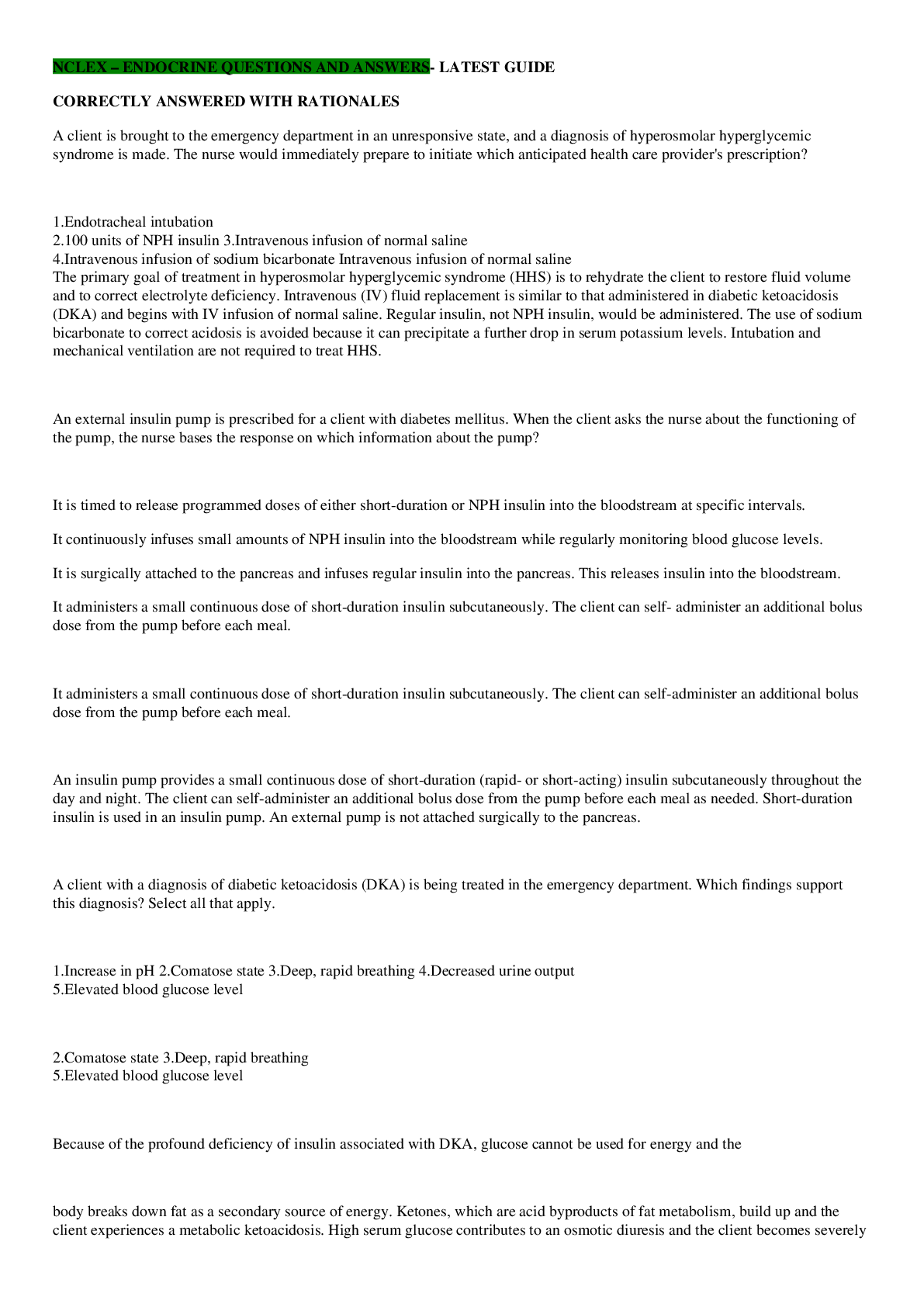
Instant download
Reviews( 0 )
Document information
Connected school, study & course
About the document
Uploaded On
Dec 14, 2022
Number of pages
47
Written in
Additional information
This document has been written for:
Uploaded
Dec 14, 2022
Downloads
0
Views
51

